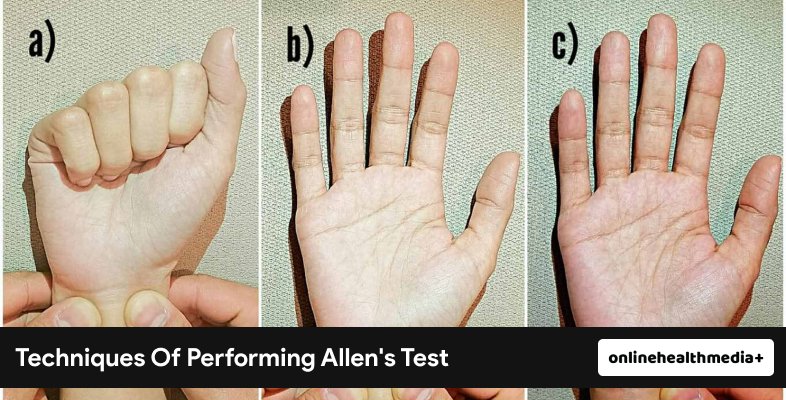Allen’s Test – Physical Examination Of Arterial Blood Flow To The Hands | Overview
Everyone wants to have a well-functioning body where nothing will be a barrier to blood circulation. Good blood circulation means a healthy supply of oxygen throughout the body. You can easily estimate the blood circulation quality of the body through Allen’s test.
First, in 1929 Edgar V. Allen described the process of performing Allen’s test. After completing that test. The modified versions of Allen’s test are adopted. In the main examination, both of them are tested simultaneously. In the modified versions of Allen’s test, each of the hands is individually tested by compressing the single artery of each hand.
So let’s see first what Allen’s test is and which pulse site is used to perform Allen’s test?
Contents
Clinical Meaning Of Allen’s Test?

Allen’s test is performed to evaluate the arteries’ blood supply to the hand. The human vasculature of the hand is complex in structures. This is a complex and vascular network. This vascular network is part of radial and ulnar arteries. The radial artery operates between the brachioradialis and flexor carpi radialis muscles of both arms.
From the wrist, this muscle is divided into many superficial branches. These superficial palmers’ branches are constructing a palmer’s branches. The deep units contribute to the deep palmar vein arch.
The flexor carpi ulnaris veins of the forearm are just upon the ulnar artery. The radial and ulnar arteries of the hand are measured by the artery flow of the blood.
Read more: Top 15 Best Liquid Vitamins For Women
How Deep Is Your Wrist Vein?

To perform Allen’s test, you have to know first how deep your wrist veins are. The veins are not very deep down your wrist. You can easily find the ulnar artery from your wrist. These veins are not very deep, and if you are going to require a small thing to inject, you only need a thin needle.
Most often, medical practitioners use the butterfly needle. For reaching your artery vein, you have to go underneath your surface veins. You will find the two artery veins from the two sides of your wrist. The artery veins supply the red blood. And the veins are blue in color, and these are the vessels returning the blood to the heart.
How deep is the vein in your wrist? The depth is easily findable. You can feel the radial artery pulse on the thumb side of the wrist. The radial artery branches from the blood supply network in hand are complex. But from both sides of your wrist, you can find the location of artery veins.
Techniques Of Performing Allen’s Test

Now is the time to perform Allen’s test to evaluate the blood circulation test. After you find the arteries compress the arteries with your fingers. Then tell your subject to clench and unclench the hand at least ten times.
After that process, tell your subject to spay out the wrist and fingers. Keep the palm in a blanched position. Then keep the ulnar artery in the releasing position. Then measure the time of the blood flow. Most often, a healthy person is only going to require less than 6 seconds to refill the palm.
You have to perform the test for both hands to measure up the exact time span. If both hand blood flow time is less than 6 seconds, then you can address the person as a fit person with normal blood pressure.
To compare the blood flow rate, you have to conduct the test for both hands of the subject. After conducting the test, compare the value of the test.
Cautions:
While performing Allen’s test, you have to keep some points in your mind to avoid mistakes.
- The hyperextension of the hands and the wide separations of the fingers are leading to a false result. To avoid making these mistakes keep the finger positions as per the directions.
- The transpalmar arch is blanched after releasing the ulnar artery. Therefore the partially open hands are more appropriate to conduct the test.
Diagnosed Value Of Performing The Allen’s Test

The poor circulation of blood flow causes multiple health conditions. The blood circulation cut off in hand is not possible unless you examine the dead person. But the refill time can differ. The poor circulation in the hands may result from a specific health condition by performing this Allen’s test. You can diagnose and evaluate the body’s blood circulation rate.
When you are going to perform the palmar arch ultrasound, you will clearly see the blood vessels in your hand. The complex structures of the understanding will help you know the exact locations of the ulnar artery. And you can efficiently perform Allen’s test.
When a person does not have any health complexity for refilling, only five to 10 seconds are enough to return the blood to their palm. So this time span is counting as the positive results. But when the time is going to take much more time than the 15 seconds, this is addressed as unnatural.
Also check: Cf24 Onyx Reviews, Benefits, Price & How It Works
FAQ (Frequently Asked Questions):
1. What Is The Reverse Allen Test?
Now you know the techniques to perform Allen’s test. But do you know a reverse process is also present in the system? The patient is instructed to tighten the first in the reverse Allen test. And both of the arteries are compressed. The redial artery is released after the fingers are getting extended.
This process is popular in the name of the reverse Allen test.
2. What Is An Allen Test In Nursing?
A bedside test is conducted for Allen’s test. The patency of the arteries of both hands is examined before the arterial puncture. Next, the patient elevates the hands and instructs the patient to make a fist. Examine the place and examine the occlusive pressure over the ulnar arteries at the wrist.
3. Which Artery Do You Need To Release During Allen’s test?
The manual compressions impede the radial and the ulnar arteries. The patient relaxes the hand. And then slowly releases the pressure from the ulnar artery. Then monitor the Collateral flow rate by measuring the palm blood refill time.
Conclusion:
By performing Allen’s test, you can calculate the whole time, and you can examine if your patient has some serious health issues are not. The best process to conduct this examination is first to keep your subject in the relaxed correct positions. Then start your examination. And keep a watch handy to calculate the exact blood refill time of your subject’s hands. Do you have any experiences like these medical examinations? Do not forget to share your opinion in the comment sections.
Read Also:
- 3 Lab Tests That You Should Get Done On Yourself
- Everything You Need to Know About the Benefits of Spinach
- Cinsulin Review, Ingredients, Benefits, Side Effects, Cost & Is It Safe?



